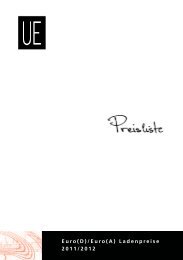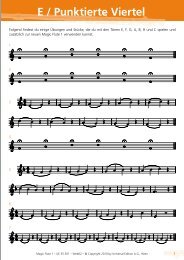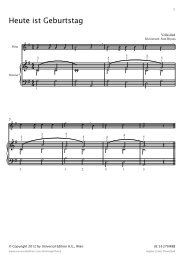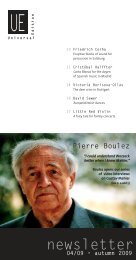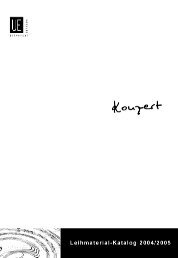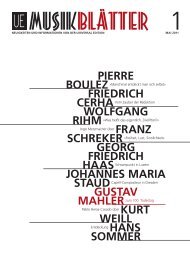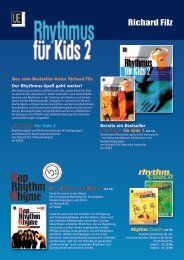Download a PDF file - Universal Edition
Download a PDF file - Universal Edition
Download a PDF file - Universal Edition
You also want an ePaper? Increase the reach of your titles
YUMPU automatically turns print PDFs into web optimized ePapers that Google loves.
22<br />
Pro<strong>file</strong> Morton Feldman<br />
enlargement of scale<br />
In his last years, from 1979 until 1987, Feldman again<br />
swerved away from the mainstream. He inaugurated his<br />
compositions of long duration, those which went on<br />
for an hour or more. Even the most devoted fans may<br />
wish to admit that there was an element of runaway<br />
grandiosity in these Wagnerian demands on the listener’s<br />
time. Feldman plotted his immortality with some<br />
deliberation – this was the man who intended to become<br />
the first great Jewish composer, ruling out Mendelssohn,<br />
Mahler, and Schoenberg – and he evidently saw this<br />
series of pieces as his tour de force, his run for home.<br />
(“I’m on third base,” he boasted in 1982.) Yet there was<br />
also a practical need for a drastic enlargement of scale. It<br />
allowed his quiet voice to be heard in the total isolation<br />
that it required. Feldman’s shorter works make an awkward<br />
effect on standard concert programs, particularly<br />
when the audience coughs and rustles its puzzlement<br />
aloud; they don’t play well with others. The long works<br />
create an overarching, protective space around a vulnerable<br />
huddle of sounds. The composer Kyle gann, in his<br />
brilliant new book, Music Downtown, describes how you<br />
end up living with Feldman’s music as you would with a<br />
painting on your wall.<br />
Extreme length allowed Feldman to approach his<br />
ultimate goal of making music into an experience of<br />
life-changing force, a transcendent art form that wipes<br />
everything else away. To sit through performances of the<br />
two biggest works – I heard Petr Kotik’s S.E.M. Ensemble<br />
play the five-hour-long For Philip Guston in 1995, with<br />
phenomenal purity of tone, and the Flux Quartet play<br />
the six-hour-long String Quartet (II) in 1999, with tireless<br />
focus – is to enter into a new way of listening, even a new<br />
consciousness. There are passages in each where Feldman<br />
seems to be testing the listener’s patience, seeing how<br />
long we can endure a repeated note or a dissonant minor<br />
second. Then, out of nowhere, some very pure, almost<br />
childlike idea materializes. Most of the closing section of<br />
For Philip Guston is in modal A minor, and it is music of<br />
surpassing gentleness and tenderness. But it inhabits a<br />
far-off, secret place that few travellers will stumble upon.<br />
In his last years, Feldman became unexpectedly<br />
wealthy. He inherited some money from his family, and<br />
he received increasing royalties from Europe, where his<br />
music was always better understood. Most significantly,<br />
he made a small fortune by selling art. Back in the fifties,<br />
he had bought a Rauschenberg canvas for seventeen dollars,<br />
because that was what he had in his pocket at the<br />
time. Shortly before his death, he sold it for six hundred<br />
thousand dollars. He became a collector of antique Middle<br />
Eastern rugs, whose subtly varied patterns affected<br />
his late style. Curmudgeonly and generous by turns, he<br />
picked up dinner tabs for hungry young composers. His<br />
final works radiate an enormous, ominous serenity:<br />
Piano and String Quartet (which Aki Takahashi has recorded<br />
beautifully with the Kronos Quartet, on Nonesuch),<br />
Palais de Mari, for piano (played by Takahashi on<br />
her mesmerizing Mode CD of early and late piano music),<br />
and Piano, Violin, Viola, Cello (recorded with icy clarity by<br />
the Ives Ensemble, on Hat Art). That piece, the very last,<br />
makes repeated, wistful references to Debussy’s Prelude<br />
Des Pas sur la Neige, or Steps in the Snow. Pancreatic<br />
cancer took Feldman quickly. one day, he was unavoidably<br />
there, monopolizing the room; the next, he was gone.<br />
There is no mistaking the lonely, lamenting tone that<br />
runs through Feldman’s music. From time to time, the<br />
composer hinted that the horrors of the twentieth century,<br />
and in particular the Holocaust, had made other, more<br />
ornate kinds of musical expression impossible for him. He<br />
explained that the title The King of Denmark, which he<br />
bestowed on a graphic piece for percussion, was inspired<br />
by King Christian x, who was occupying the Danish<br />
throne when the germans invaded his country in 1940.<br />
Feldman proceeded to tell the story, now considered<br />
apocryphal, of King Christian responding to german anti-<br />
Semitism by walking the streets with a yellow star pinned<br />
to his chest. It was a “silent protest,” Feldman said. In a<br />
way, his music seemed to protest all of European civilization,<br />
which, in one way or another, had been complicit<br />
in Hitler’s crimes. The American composer Alvin Curran<br />
once saw Feldman at a german festival, and asked him,<br />
in light of the enthusiasm that he was inspiring there,<br />
why he didn’t move to germany. Feldman stopped in the<br />
middle of the street, pointed down at the cobblestones,<br />
and said, “Can’t you hear them? They’re screaming! Still<br />
screaming out from under the pavements!”<br />
synagogal chant<br />
If there is a Holocaust memorial in Feldman’s work, it is<br />
Rothko Chapel, which was written in 1971, for Rothko’s<br />
octagonal array of paintings in Houston. Rothko had committed<br />
suicide the previous year, and Feldman, who had



